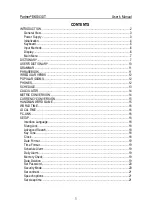
9-22
Effects
Tremolo and AutoPan
Tremolo and AutoPan
Tremolo
is
amplitude
modulation
using
an
LFO.
AutoPan
moves
the
signal
between
the
left
and
right
channels,
using
an
LFO.
They
have
several
parameters
in
common
and
several
unique
ones.
LFO
Rate
is
the
rate
of
the
LFO.
The
range
is
0
to
10.00
Hz,
or
in
Tremolo
BPM
algorithm,
0
to
12.00
x
the
tempo.
Rate
Scale
multiplies
the
speed
of
the
LFO
rate
into
the
audio
range.
The
range
is
1
to
25088
x
.
When
above
16
x
,
the
values
increment
in
semitone
steps.
When
the
LFO
Rate
is
set
to
1.00
Hz,
the
value
of
this
parameter
is
equal
to
the
LFO
frequency
in
Hertz.
LFO
Shape
is
the
waveform
type
for
the
LFO.
Choices
are
Sine,
Saw+,
Saw
‐
,
Pulse,
and
Tri.
LFO
PlsWid
or
Pulse
Width
.
When
the
LFO
Shape
is
set
to
Pulse,
this
sets
the
pulse
width
as
a
percentage
of
the
waveform
period.
When
the
width
is
set
to
50%,
the
result
is
a
square
wave.
This
parameter
has
no
effect
if
other
waveform
types
are
chosen.
Range
is
0
to
100%.
AutoPan
Origin
determines
the
axis
for
the
panning
motion.
At
0%,
the
panning
is
centered
between
the
speakers.
Positive
values
shift
the
axis
to
the
right,
while
negative
values
shift
it
to
the
left.
At
‐
100%
or
+100%
(the
range
limits),
there
is
no
panning
action.
ImageWidth
is
the
width
of
the
original
input
program
material
before
it
is
auto
‐
panned.
At
0%
(minimum),
the
input
image
is
shrunk
to
a
single
point
source,
allowing
maximum
panning
excursion.
At
100%
(maximum),
the
original
width
is
maintained
so
no
panning
can
occur.
Pan
Width
controls
the
amount
of
pan
excursion.
It
is
the
percentage
of
total
panning
motion
available
after
Origin
and
ImageWidth
are
set.
Range
is
0
to
100%.
CentrAtten
(Attenuation)
is
the
amount
the
signal
level
drops
as
it
is
panned
through
the
center
of
the
stereo
image.
For
the
smoothest
tracking,
a
widely
accepted
subjective
reference
is
‐
3dB.
Values
above
‐
3dB
will
cause
somewhat
of
a
bump
in
level
as
an
image
passes
through
the
center,
while
values
below
‐
3dB
will
cause
a
dip.
Range
is
‐
12
to
0
dB.
Tremolo
Depth
controls
the
amount
of
attenuation
applied
when
the
LFO
is
at
its
deepest
excursion
point.
Range
is
0
to
100%.
LFO
Phase
shifts
the
phase
of
the
tremolo
LFO
relative
to
the
beat
reference.
Range
is
0.0
to
360.0
degrees.
50%
Weight
is
the
relative
amount
of
attenuation
added
when
the
LFO
is
at
the
‐
6dB
point.
This
causes
the
LFO
shape
to
bow
up
(positive
values)
or
down
(negative
values).
Range
is
‐
16
to
3
dB.
L/R
Phase
sets
the
phase
relationship
of
the
channels.
“In”
flips
the
left
channel’s
LFO
out
of
phase,
with
the
result
that
the
effect
turns
into
an
auto
‐
balancer.
“Out”
leaves
the
left
LFO
alone.
Pitcher
Pitcher
applies
a
filter
to
the
input
signal
which
has
a
series
of
peaks
in
the
frequency
response.
These
peaks
are
normally
adjusted
so
that
their
frequencies
are
all
multiples
of
a
specific,
selectable
frequency,
which
imposes
a
strong
sense
of
pitch
at
the
selected
fundamental
frequency.
Summary of Contents for PC3K6
Page 24: ...1 6 Introduction Options...
Page 50: ...4 4 The Operating Modes Using the Modes...
Page 58: ...5 8 Editing Conventions Special Button Functions...
Page 130: ...6 72 Program Mode Programming Tips...
Page 202: ...7 72 Setup Mode Recording A Setup To Song Mode...
Page 206: ...8 4 Quick Access Mode The QA Editor...
Page 232: ...9 26 Effects Mono Algorithms...
Page 268: ...11 18 Master Mode Preview Sample PRVIEW...
Page 302: ...12 34 Song Mode and the Song Editor Song Editor The EVENT Page...
Page 328: ...14 14 Keymap and Sample Editing Editing Samples...
Page 334: ...B 4...
Page 370: ...D 32 PC3K Objects V 1 31 Effect Chains...
Page 372: ...E 2 PC3K Legacy File Conversion Object Types and Conversion Details...
















































